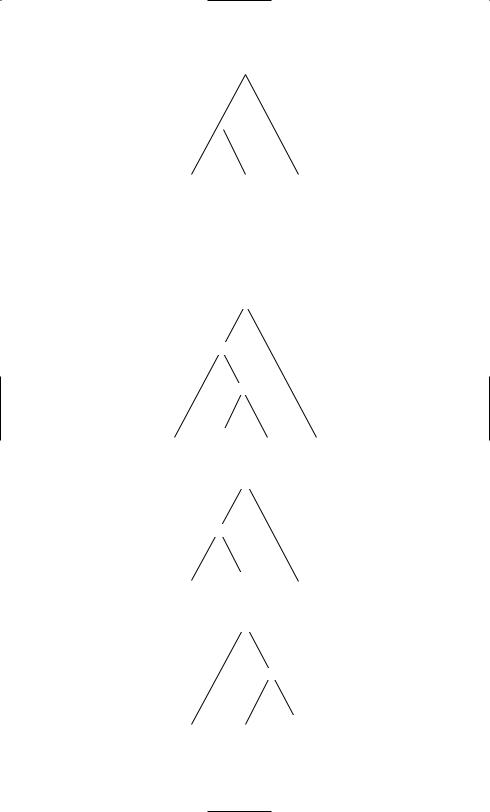
An_Introduction_to_English_Morphology
.pdf
DISCUSSION OF THE EXERCISES |
123 |
as a very unusual cranberry morpheme (a root consisting of less than a syllable); so it seems better to treat unique as monomorphemic in modern English, the similarity between unique and uni- being merely a reflection of their common historical source in Latin.
(c)decorat-ing, de-centr-al-is-ing. Both words clearly end with the suffix -ing. You may be tempted to split decorat(e)- further into decor and -at(e), especially as -at(e) appears elsewhere in a wide variety of verbs such as generate, speculate, rotate and impersonate. The question then arises whether the remaining element decor- should be treated as the same morpheme as the word decor. Similar issues arise in question 5.
It is clear that decorate does not contain the negative prefix de- that appears in decentralising, along with the common suffixes -al and -is(e) (sometimes spelled -iz(e)).
(d)whole-some, grue-some. The suffix -some is reasonably common in modern English, although brand-new words cannot be formed with it. Other words containing it are awesome, fearsome, quarrelsome and tiresome. However, the element grue- crops up in no other word, so is a cranberry morpheme.
(e)con-sume-d, con-sump-tion. The past tense suffix -(e)d is clearly identifiable here, as well as the suffix -tion that is very common in nouns with abstract meanings (attraction, perfection, completion etc.). What is less immediately clear is whether these words should be considered to contain a prefix con-, with no consistent meaning. The discussion of example (2) in this chapter suggests that the anwer is yes. Question 2 (discussed below) brings in a further consideration relating to the root.
(f ) erythro-cyte, leuco-cyte. Any reader who was unfamiliar with these words has probably looked them up and found that they mean ‘red blood cell’ and ‘white blood cell’ respectively. This confirms that they are polymorphemic, the morphemes in question being combining forms (derived, in this instance, from Greek).
2. As discussed in the chapter, the plural suffix -s on tigers and speakers has three different allomorphs, [s], [z] and [əz]; in both these examples its shape is [z]. Of the other morphemes identifiable here, centr(e)- and -sum(e)/-sump- have more than one allomorph. As a word on its own, centre has two syllables, but in decentralising it has just one; this is connected to the fact that the suffix -al that follows it begins with vowel. The -sump- allomorph of -sum(e) that we find in consumption also shows up in presumption; it appears before -tion and nowhere else. There is a similar parallel between assume and resume on the one hand and assumption

124 |
AN INTRODUCTION TO ENGLISH MORPHOLOGY |
and resumption on the other. This constitutes good evidence that all these words really do contain a shared root morpheme, even though it is hard to identify a clearcut meaning for it in contemporary English. Its allomorphs begin with [z] after prefixes beginning with a vowel (re-, pre-), and with [s] elsewhere; and they end in -ump- before -tion, -um(e) elsewhere. (The existence of an unusual allomorph before -tion parallels the allomorphy of -duce and -volve, discussed in the chapter.)
3.The bound morphemes include the following affixes (affixes being bound by definition): -s, -er, un-, -ly, -ing, de-, -al, -is(e), -some, -(e)d, con-,
-tion. Also bound by definition are Graeco-Latin combining forms, illustrated here by erythro-, leuco- and -cyte. The roots grue- and -sum(e)/-sump- are also bound, inasmuch as they cannot occur on their own.
With centre, the distinction between a morpheme and its allomorphs is important. The morpheme as a whole is clearly free, but its one-syllable allomorph [sentr] (as in central, centrifugal, centrist) is bound.
4.Most of the morphemes identified in answer to question 1 have a clearcut meaning, or at least (in the case of the verb-forming suffix -ate) a clearcut linguistic function. (See Chapters 4 and 5 for more on the linguistic functions of affixes.) However, this cannot be said of grue- or -sum(e). Grue- is a cranberry morpheme, occurring only in the word gruesome, so it is only gruesome as a whole that can be called meaningful, one may argue. As for -sum(e), although it is identifiable as a morpheme in many words (see the discussion of questions 1 and 2), it makes no consistent contribution to their meaning.
5.Three roots in (1b) arguably have free allomorphs: rend- in rendition (if it is treated as an allomorph of render), clar- in clarity (if it is treated as an allomorph of clear), and applic- in applicant (if it is treated as an allomorph of apply).
The existence of words such as audition, magnificent, clarify and applicable show that their roots are not cranberry morphemes. But the root leg- is virtually a cranberry morpheme (as stated in the chapter), and obfusc- certainly is, because it occurs nowhere except in obfuscate.
If rend- in rendition is linked to render, then it is not a cranberry morpheme, but it could be called a ‘cranberry allomorph’, since the allomorph rend- occurs in no other word.
6.The allomorphy is as follows:
•when the preceding sound is a t or d sound, as in wait or load, the [ d] allomorph occurs

DISCUSSION OF THE EXERCISES |
125 |
•otherwise, when the preceding sound is voiceless (as in rip, lick, watch or wash), the [t] allomorph occurs
•otherwise (i.e. after a vowel or a voiced consonant, as in drag or play), the [d] allomorph occurs.
The second and third conditions are the same as for the plural -s; only the first is different.
Chapter 4
1(a) Woman and women are forms of the same lexeme, representing the singular of and the plural of respectively. Woman’s is not a form of because, as explained in the chapter, -’s is not an inflectional affix, so woman’s is formed syntactically rather than morphologically. The adjective and the noun are different lexemes from , although of course related in meaning.
(b) The word form green is ambiguous: it can be a form of the adjectivedenoting a colour, or of the noun meaning ‘area covered in grass’, as in ‘village green’ or ‘bowling green’. In the first sense, green is in the same lexeme as the comparative form greener ; in the second sense, it is in the same lexeme as the plural form greens (which is also the sole form of another lexeme meaning ‘vegetables’). In neither sense is green in the same lexeme as greenish.
(c) Written and wrote are the perfect participle and the past tense forms of the verb lexeme . Writing may be the progressive form of the same lexeme, or it may be the singular form of the noun (as in His writing is illegible). Writer is the singular form of the noun , and rewrites is the third person singular present form of the verb , or possibly the plural of the noun , with stress on the first syllable rather than the second (as in Many rewrites were necessary before that novel was accepted for publication).
2(a) nooses ; (b) geese ; (c) usually moose (like sheep, deer); (d) played; (e) laid ;
(f) lay ; (g) lied; (h) was ; (i) dived or, especially in North America, dove ;
(j) striven or strived; (k) glided; (l) ridden; (m) see below; (n) you; (o) us. To many native speakers, in the context We have ____ over the hills all
day, none of the forms strode, stridden or strided sounds quite right. For these speakers, unexpectedly, no perfect participle of seems to exist, so the verb is defective in this respect.
3(b) geese ; (f ) lay ; (h) was ; (i) dove ; (j) striven ; (l) ridden; (m) us are irregular (or, at least, do not follow the majority pattern). Of these, was and us

126 |
AN INTRODUCTION TO ENGLISH MORPHOLOGY |
are suppletive. Moose deserves to be called regular, because it follows the special pattern of suffixless plurals for game animals.
The difference in spelling between played and laid may make it seem that one or the other must be irregular. However, the difference is solely one of spelling; in terms of pronunciation, they are both formed regularly, with the [d] allomorph of the -ed suffix. (The form said from is not exactly parallel, because it is irregular in pronunciation: [sed].)
4. has the suppletive comparative form worse (and superlative worst). Less may be regarded as a suppletive comparative of (e.g. There is little water in this jug, and there is even less water in that one). The comparative of , further or farther, is sufficiently similar to far to count as irregular rather than suppletive.
5. The word forms gentlest, commonest and remotest are in general use. (Remotest appears in the cliché I haven’t the remotest idea.) On the other hand, most precise sounds better than precisest.
Chapter 5
1. The nouns that you are most likely to think of in the first instance are ones denoting the activity of the verb or some result of that activity:
|
, |
|
|
, |
|
|
, |
|
What is striking here is the lack of consistency among verbs that share the same root. For example, there is no obvious reason why and should exist while ‘ ’ and ‘ ’ do not. To this extent, the existence of and is unpredictable, and they must be treated as lexical items. The same goes for all these twelve nouns.
Unpredictability of existence does not entail unpredictability of meaning. The meanings of and are just what one would expect on the basis of the meanings of the corresponding verbs. However, some of these nouns do have more or less unpredictable meanings. C can have the special meaning ‘confinement of a woman in childbirth’. The meanings of and are related to distinct non-overlapping senses of : ‘consult or discuss’ and ‘award or grant’ respectively. The same applies to the other nouns with the root -fer.
A noun exists, alongside and ,

DISCUSSION OF THE EXERCISES |
127 |
but a moment’s thought will confirm that it is derived from , not(compare and ). There are also nounsand , whose meaning has little now to do with that of but which might still be argued to preserve a derivational relationship to it, in parallel with the relationship between
and .
The agentive or instrumental suffix -er can added quite freely to English verbs, and these verbs are no exception; however, of the -er nouns so formed, the only one in common use is , whose meaning is sufficiently idiosyncratic to be lexicalised.
Finally, from can be formed , lexicalised with the meaning ‘place where a raw material (e.g. crude oil, sugar cane) is converted into a finished product’.
2. No entirely general method of forming verbs from adjectives exists in English, so any verbs corresponding to these adjectives must be lexical items, even if their meanings are predictable.
The only verb formed solely by prefixation from an adjective in this list is . Verbs formed by conversion are and . Verbs formed by suffixation are , and . Verbs that apparently show prefixation as well as suffixation are and; but these are derived from the verbs andrather than directly from and .
There are no verbs derived from , , and . That is not to say that English has no words to express the corresponding meanings (e.g. ‘cause to be full’ or ‘become full’): in fact, there are verbs ,and . F is arguably derived from , but if so the process involved is an idiosyncratic vowel change, unparallelled elsewhere. The relationship between and parallels that between and , discussed in the chapter.
The lack of a verb corresponding to seems at first sight strange, given the existence of a verb ( ) corresponding to an adjective that means the opposite of . But this seems less strange when one notices that denotes only a mental state, while can relate also to external circumstances, independent of mental state; and the verb(like ) relates primarily to external circumstances. (A person who is humbled in defeat does not necessarily acquire humility!)
Of the verbs we have noted, some are transitive only ( ,, and ); ones that may also be intransitive are
, , , , and perhaps .
3. The suffix -ism is often attached to proper names, to mean ‘doctrine

128 |
AN INTRODUCTION TO ENGLISH MORPHOLOGY |
associated with X’: e.g. B , M , T . It also crops up with other noun bases (e.g. , , ), and with some bases whose word class is hard to determine because they are bound (e.g. , , , ).
4.The suffix -ful, attached to nouns, can have the meaning ‘amount that can be contained in X’, e.g. , , , .
5.Adjectives derived by means of -ly are not numerous, but some of them are common: e.g. , , , , (from nouns), and , , (from adjectives). This adjectival
-ly is not combinable with the adverb-forming -ly, however. Some English speakers, including me, find acceptable the adverb formed from , where the first -ly is not a suffix but part of the root, but reject the adverb * formed from the already suffixed adjective . Notice that the word form kindly can represent either the adverb ‘in a kind fashion’ or the adjective ‘kind-hearted’. Similarly, chiefly can represent either an adjective formed from the noun(as in his chiefly authority) or an adverb from the adjective (as in They chiefly eat rice alongside Their chief food is rice).
6. Your list of -ar adjectives probably includes examples such as ,
, , , , , , and -
. In all of these, the base contains the sound /l/. By contrast, most adjectives in -al have bases that lack /l/ (although there are some exceptions, e.g. , ).
7. The technique is to construct verbal and nominal contexts where cook can appear, and then see what other verb-noun pairs can appear in the same or similar contexts. Consider:
(i)They cooked all the food.
(ii)The cooks were busy.
For cooked in (i), one can substitute baked, sold or organised, and in (ii) one can substitute bakers, sellers or organisers. Since these agent nouns are derived from the corresponding verbs by suffixation of -er, it seems reasonable to treat the noun as derived from the verb too, although without a suffix. (The suffixed noun also exists, but denotes an appliance rather than a person.)
8. Let us first try using as the core, or base, for affixation. Actual or possible words include ‘little dog’, ‘dog-related’,

DISCUSSION OF THE EXERCISES |
129 |
‘not dog-like’; less likely but still possible as a jocular creation - ‘removal of dogs (and things related to dogs) from’ (-ific- being the allomorph of -ify that appears before -ation, as in , derived from ). However, evenuses only three affixes. One can do more with. With two prefixes and three suffixes, one can form, with the meaning ‘the process of again reversing distribution into compartments’. This is a lexeme that you have almost certainly never met, but it is a conceivable (though inelegant) item of technical jargon.
Chapter 6
1(a) Moonlight is a NN compound noun (and hence a lexeme), with the expected stress on the first element. Moonscape is too, but it is unusual in that -scape is a bound morpheme, found also in landscape and seascape. Harvest moon has an institutionalised meaning (the full moon closest to the end of September in the northern hemisphere), but is nevertheless a phrase rather than a compound. The same goes for blue moon, which is a phrase inside a phrasal idiom (see Chapter 2).
(b)Blueberry, bluebottle and greybeard are AN compound nouns. Sky-blue is a NA compound adjective. Blue-pencil, meaning ‘censor’ or ‘cut’, is a verb derived by conversion from a nominal source (see Chapter 5), but the source is not a word but rather a phrase (blue pencil as a conventional term for what a censor uses in crossing out objectionable passages). It is therefore a phrasal word rather than a compound.
(c)Pencil case, eyebrow pencil and pencil sharpener are NN compound nouns; eyebrow pencil also contains the NN compound noun eyebrow. Pencil-thin is a NA compound adjective. Thin air is not a word but a phrase (though it is part of a cliché).
(d)Airport and air conditioning are NN compound nouns. (The stress on air rather than on conditioning supports the analysis as a compound rather than a phrase.) Air force is also a NN compound noun, but Royal Air Force is a phrase consisting of an adjective and a noun, just like effective air force or royal palace; the fact that the Royal Air Force is lexicalised as a name for the British air force does not affect its status as a phrase. Air France presents the same analytic dilemma as governor general does: is it a lexicalised phrase in which the modifier (France) follows the head (Air), or is it a left-headed compound noun? Either way, the pattern is unusual, though not without parallels in proper names of companies or insti-

130 |
AN INTRODUCTION TO ENGLISH MORPHOLOGY |
tutions (e.g. Air Canada, Virgin Atlantic, Tate Modern). Perhaps this structure is popular in such names because, being head-first, it has a whiff of sophistication derived from the head-first structure of noun phrases in French (where nouns generally precede adjectives).
(e) Silkworm and T-shirt are NN compound nouns. Silk shirt, however, is a phrase consisting of a head noun (shirt) and a modifier (silk) which also happens to be a noun.
(f ) The plural of lady-in-waiting is ladies-in-waiting, not *lady-in-waitings, which shows that, like brother-in-law, it is a noun phrase, not a word (despite the hyphens). All the other examples are nouns, pluralised by adding -s at the end, but their structure is that of a phrase (e.g. stick in the mud, want to be) rather than a word, so they are not compounds but phrasal words.
(g) Overrún is a compound verb of PV shape, from which the noun óverrun is formed by conversion (see Chapter 5), with a stress shift – the same stress shift as seen in (for example) the nouns tórment and prótest, formed from the verbs tormént and protést. Undercoat is a compound noun of PN shape, from which the verb undercoat is formed by conversion, but here there is no stress shift. (Compare other denominal verbs such as father in to father a child and commission in to commission a portrait ; these also show no change in the stress pattern of the base noun.) Underhand is an adjective consisting of a preposition and a noun, so, although under hand is not a well-formed phrase, it makes sense to analyse it in the same way as offshore and in-house, discussed in Section 5 of the chapter. Hándover is a noun derived by conversion from a verbal source, but this source is a phrase rather than a word (hand over, as in they handed the money over); it thus resembles blue-pencil in (b) above, except that the conversion is in the opposite direction.
2(a) Moonlight and moonscape are both endocentric.
(b) Blueberry and sky-blue are endocentric. Bluebottle is also endocentric, because, although a bluebottle (whether a kind of fly, a kind of plant or a kind of jelly-fish) is not a bottle, its name likens it metaphorically to one. On the other hand, greybeard is exocentric because it denotes not a kind of beard nor something that resembles a beard, but rather someone who typically has a grey beard (an old man). Blue-pencil is also exocentric because, though a verb, it has no verbal head.
(c), (d), (e) All are endocentric.
(f ) None of these is a compound, so the question does not apply.

DISCUSSION OF THE EXERCISES |
131 |
(g) Overrún (verb) and undercoat (noun) are endocentric. Their derivatives by conversion, óverrun and undercoat (verb), are exocentric, as are underhand (an adjective with no adjectival head) and handover (a noun with no nominal head).
3.The only secondary compounds are pencil sharpener and air conditioner, in which pencil and air are interpreted as objects of the verbal elements sharpen and condition (the latter being a verb derived by conversion from a noun).
4.breakfast plus lunch ; motor plus hotel ; radio detecting and ranging ; modulator plus demodulator ; light amplification by stimulated emission of radiation.
5.nano- ‘one thousand millionth (or billionth) of ’; also in nanometer proto- ‘first’; also in protozoon
-plasm ‘predominant substance in living cells’; also in cytoplasm endo- ‘internal’; also in endogamy
-centric ‘having a centre’; also in polycentric poly- ‘many’; also in polycentric
-phony ‘sound’; also in telephony
leuco- ‘white’; also (with different spelling) in leukaemia -cyte ‘cell’; also in cytoplasm and erythrocyte
omni- ‘all’; also in omniscient -vorous ‘eating’; also in carnivorous octa- ‘eight’; also in octagon -hedron ‘surface’; also in polyhedron
Chapter 7
1. In these tree diagrams, an italicised item is the head of the smallest constituent that contains it, e.g. the suffix -y (or -i-) is the head of greedy, and -ness is the head of greediness.
|
N |
|
|
A |
|
N |
|
|
greed |
i |
ness |
(The change from -y to -i- in greediness is purely orthographic, with no linguistic significance.)

132 |
AN INTRODUCTION TO ENGLISH MORPHOLOGY |
||||||
|
|
|
|
|
|
|
|
|
|
|
|
N |
|
||
|
|
|
|
|
|
|
|
|
|
V |
|
||||
|
|
|
|
|
|
|
|
|
|
|
|
V |
|
||
|
de |
consecrat |
ion |
||||
Arguably, consecrate is itself complex, with a verb-forming suffix -ate added to a base consecr-, in turn consisting of a prefix con- and a bound root secr-, perhaps an allomorph of sacred. However, no clearcut meaning can be assigned to con-. (Problems in analysing this kind of word were discussed in Chapter 2.)
|
|
N |
|
|
A |
|
|
|
|
A |
|
|
V |
|
|
in |
corrupt |
ibil |
ity |
|
|
N |
|
|
V |
|
|
N |
|
en |
throne |
ment |
|
V |
|
|
|
V |
|
|
V |
re |
un |
cover |
